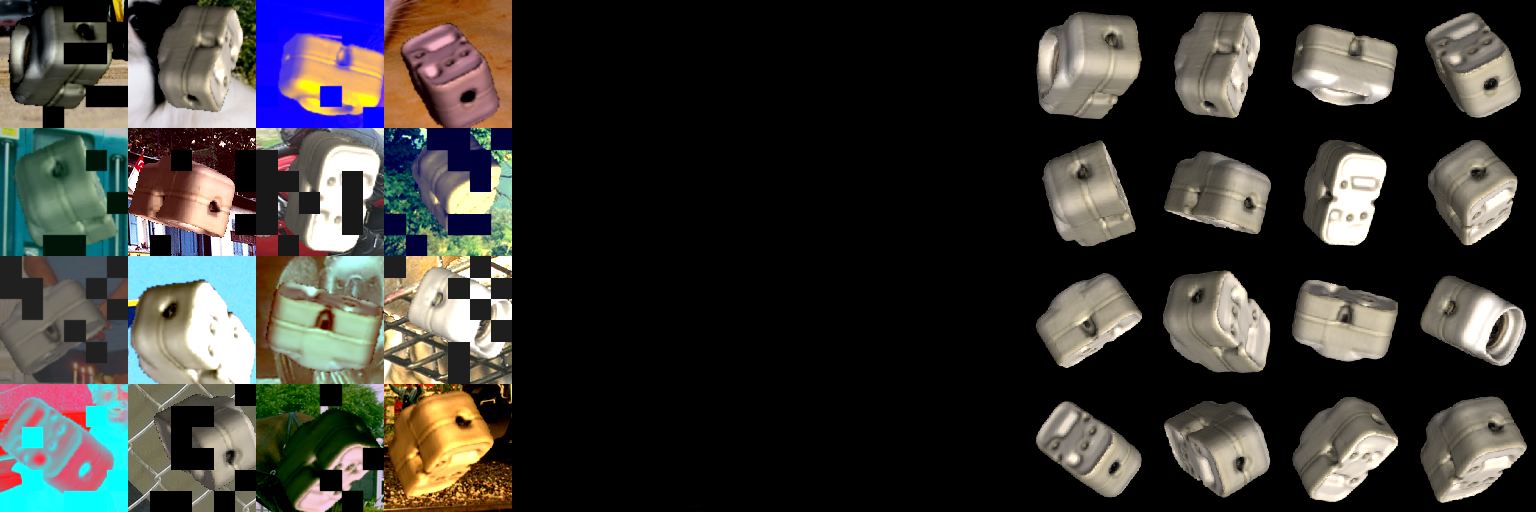Martin Sundermeyer, Zoltan-Csaba Marton, Maximilian Durner, Manuel Brucker, Rudolph Triebel
Best Paper Award, ECCV 2018.
If you find Augmented Autoencoders useful for your research, please consider citing:
@InProceedings{Sundermeyer_2018_ECCV,
author = {Sundermeyer, Martin and Marton, Zoltan-Csaba and Durner, Maximilian and Brucker, Manuel and Triebel, Rudolph},
title = {Implicit 3D Orientation Learning for 6D Object Detection from RGB Images},
booktitle = {The European Conference on Computer Vision (ECCV)},
month = {September},
year = {2018}
}
1.) Train AAE using only a 3D model to predict 3D Object Orientations from RGB image crops
2.) For full RGB-based 6D pose estimation, also train a 2D Object Detector
e.g. using the optimized google detection API: https://github.com/naisy/train_ssd_mobilenet
or like in the paper
https://github.com/fizyr/keras-retinanet
https://github.com/balancap/SSD-Tensorflow
3.) Optionally, use the standard depth-based ICP to refine the 6D Pose
Nvidia GPU with >4GB memory (or adjust the batch size)
RAM >8GB
Duration depending on Configuration and Hardware: ~3h per Object
Linux, Python 2.7
GLFW for OpenGL:
sudo apt-get install libglfw3-dev libglfw3 Assimp:
sudo apt-get install libassimp-dev Tensorflow >= 1.6
OpenCV >= 3.1
pip install --pre --upgrade PyOpenGL PyOpenGL_accelerate
pip install cython
pip install cyglfw3
pip install pyassimp
pip install imgaug
pip install progressbar1. Pip installation
pip install .2. Set Workspace path, consider to put this into your bash profile, will always be required
export AE_WORKSPACE_PATH=/path/to/autoencoder_ws 3. Create Workspace, Init Workspace
mkdir $AE_WORKSPACE_PATH
cd $AE_WORKSPACE_PATH
ae_init_workspace- Currently remote training is not supported since glfw 3.2. does not allow headless rendering even with X Server forwarding1. Create the training config file. Insert the paths to your 3D model and background images.
mkdir $AE_WORKSPACE_PATH/cfg/exp_group
cp $AE_WORKSPACE_PATH/cfg/train_template.cfg $AE_WORKSPACE_PATH/cfg/exp_group/my_autoencoder.cfg
gedit $AE_WORKSPACE_PATH/cfg/exp_group/my_autoencoder.cfg2. Generate and check training data. The object views should be strongly augmented but identifiable. (Press ESC to close the window.)
ae_train exp_group/my_autoencoder -dThis command does not start training.
Output:

3. Train the model
ae_train exp_group/my_autoencoder4. Create the embedding
ae_embed exp_group/my_autoencoderhave a look at /auto_pose/test/
Feed one or more object crops from disk into AAE and predict 3D Orientation
python aae_image.py exp_group/my_autoencoder -f /path/to/image/file/or/folderThe same with a webcam input stream
python aae_webcam.py exp_group/my_autoencoderMulti-object real-time RGB-based 6D Object Detection from a Webcam stream
Train a 2D detector following https://github.com/naisy/train_ssd_mobilenet
adapt /auto_pose/test/googledet_utils/googledet_config.yml
python aae_googledet_webcam_multi.py exp_group/my_autoencoder exp_group/my_autoencoder2 exp_group/my_autoencoder3might need a bit effort to get running but results are worth it:
[embed a video demonstration]
For the evaluation you will also need https://github.com/thodan/sixd_toolkit + our extensions, see sixd_toolkit_extension/help.txt
Create the evaluation config file
mkdir $AE_WORKSPACE_PATH/eval_cfg/eval_group
cp $AE_WORKSPACE_PATH/eval_cfg/eval_template.cfg $AE_WORKSPACE_PATH/eval_cfg/eval_group/eval_my_autoencoder.cfg
gedit $AE_WORKSPACE_PATH/cfg/eval_group/eval_my_autoencoder.cfgSet estimate_bbs=False in the evaluation config
ae_eval exp_group/my_autoencoder name_of_evaluation --eval_cfg eval_group/eval_my_autoencoder.cfg
e.g.
ae_eval tless_nobn/obj5 trained_without_batchnorm --eval_cfg tless/5.cfgGenerate a training dataset for T-Less using detection_utils/generate_sixd_train.py
python detection_utils/generate_sixd_train.pyTrain https://github.com/fizyr/keras-retinanet or https://github.com/balancap/SSD-Tensorflow
Then continue as stated above
[Paths]
# Path to the model file. All formats supported by assimp should work. Tested with ply files.
MODEL_PATH: /path/to/my_3d_model.ply
# Path to some background image folder. Should contain a * as a placeholder for the image name.
BACKGROUND_IMAGES_GLOB: /path/to/VOCdevkit/VOC2012/JPEGImages/*.jpg
[Dataset]
#cad or reconst (with texture)
MODEL: reconst
# Height of the AE input layer
H: 128
# Width of the AE input layer
W: 128
# Channels of the AE input layer (default BGR)
C: 3
# Distance from Camera to the object in mm for synthetic training images
RADIUS: 700
# Dimensions of the renderered image, it will be cropped and rescaled to H, W later.
RENDER_DIMS: (720, 540)
# Camera matrix used for rendering and optionally for estimating depth from RGB
K: [1075.65, 0, 720/2, 0, 1073.90, 540/2, 0, 0, 1]
# Vertex scale. Vertices need to be scaled to mm
VERTEX_SCALE: 1
# Antialiasing factor used for rendering
ANTIALIASING: 8
# Padding rendered object images and potentially bounding box detections
PAD_FACTOR: 1.2
# Near plane
CLIP_NEAR: 10
# Far plane
CLIP_FAR: 10000
# Number of training images rendered uniformly at random from SO(3)
NOOF_TRAINING_IMGS: 10000
# Number of background images that simulate clutter
NOOF_BG_IMGS: 10000
[Augmentation]
# Using real object masks for occlusion (not really necessary)
REALISTIC_OCCLUSION: False
# During training an offset is sampled from Normal(0, CROP_OFFSET_SIGMA) and added to the ground truth crop.
CROP_OFFSET_SIGMA: 20
# Random augmentations at random strengths from imgaug library
CODE: Sequential([
#Sometimes(0.5, PerspectiveTransform(0.05)),
#Sometimes(0.5, CropAndPad(percent=(-0.05, 0.1))),
Sometimes(0.5, Affine(scale=(1.0, 1.2))),
Sometimes(0.5, CoarseDropout( p=0.2, size_percent=0.05) ),
Sometimes(0.5, GaussianBlur(1.2*np.random.rand())),
Sometimes(0.5, Add((-25, 25), per_channel=0.3)),
Sometimes(0.3, Invert(0.2, per_channel=True)),
Sometimes(0.5, Multiply((0.6, 1.4), per_channel=0.5)),
Sometimes(0.5, Multiply((0.6, 1.4))),
Sometimes(0.5, ContrastNormalization((0.5, 2.2), per_channel=0.3))
], random_order=False)
[Embedding]
# for every rotation save rendered bounding box diagonal for projective distance estimation
EMBED_BB: True
# minimum number of equidistant views rendered from a view-sphere
MIN_N_VIEWS: 2562
# for each view generate a number of in-plane rotations to cover full SO(3)
NUM_CYCLO: 36
[Network]
# additionally reconstruct segmentation mask, helps when AAE decodes pure blackness
AUXILIARY_MASK: False
# Variational Autoencoder, factor in front of KL-Divergence loss
VARIATIONAL: 0
# Reconstruction error metric
LOSS: L2
# Only evaluate 1/BOOTSTRAP_RATIO of the pixels with highest errors, produces sharper edges
BOOTSTRAP_RATIO: 4
# regularize norm of latent variables
NORM_REGULARIZE: 0
# size of the latent space
LATENT_SPACE_SIZE: 128
# number of filters in every Conv layer (decoder mirrored)
NUM_FILTER: [128, 256, 512, 512]
# stride for encoder layers, nearest neighbor upsampling for decoder layers
STRIDES: [2, 2, 2, 2]
# filter size encoder
KERNEL_SIZE_ENCODER: 5
# filter size decoder
KERNEL_SIZE_DECODER: 5
[Training]
OPTIMIZER: Adam
NUM_ITER: 30000
BATCH_SIZE: 64
LEARNING_RATE: 1e-4
SAVE_INTERVAL: 5000
[Queue]
# number of threads for producing augmented training data (online)
NUM_THREADS: 10
# preprocessing queue size in number of batches
QUEUE_SIZE: 50